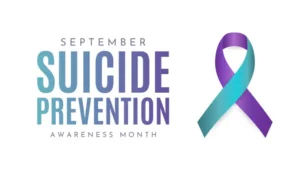
In 2021, suicide was the 11th leading cause of death in the U.S. According to the CDC, 48,143 Americans died by suicide, and there were roughly 1.7 million attempts in 2021. The American Foundation for Suicide Prevention (AFSP) recognizes September as National Suicide Prevention Month, a time to create awareness of this leading cause of death and learn how to play a role in helping to save lives.
This year, the AFSP is using the “Talk Away the Dark” campaign to shed light on this issue by teaching the risks, signs, and resources to be used to help prevent suicide. Click here to visit the campaign.
Advocation and education are two of the best ways to combat suicide. In this blog, see the signs, destigmatize your own opinions, and learn how to help those around you.
The Facts and Statistics
According to the Centers for Disease Control and Prevention (CDC) Data & Statistics’ 2021 Fatal Injury Report:
- The rate of suicide is highest in middle-aged white men.
- In 2021, men died by suicide 3.90 times more than women.
- On average, there are 132 suicides per day.
- White males accounted for 69.68% of suicide deaths in 2021.
- In 2021, firearms account for 54.64% of all suicide deaths.
And most importantly, 94% of U.S. adults think suicide can be prevented.
Risk Factors
- Mental Health Disorders
- Individuals who suffer from mental health conditions such as depression, anxiety, or bipolar disorder are at a much higher risk of suicide.
- Chronic Disease and Physical Health Issues
- Substance Abuse Disorder (SUD)
- Traumatic Brain Injuries
- Stressful or triggering major life events.
- Family history of mental illness or suicide.
- Previous suicide attempts.
- Childhood abuse, neglect, or trauma.
Warning Signs
Signs of suicide ideation are not one size fits all. Sometimes, people experience no warning signs, but being aware of the most common is important in prevention. Several warning signs are listed below:
- Talks about suicide or ending their life.
- Feelings of hopelessness.
- Having beliefs that life cannot get better.
- Withdrawing from activities they normally participate in.
- Isolating themselves from family and friends.
- Giving away their possessions.
- Visiting, writing, or telling loved one‘s goodbye.
Treatment and Prevention
There are several opportunities for suicide treatment and prevention that are easily accessible, including:
- Therapy
- Intervention
- Creating safety and crisis plans to utilize the AFSP toolkits.
- Medication and involvement from a psychiatric professional.
- 988 Lifeline
- 24/7 help via SMS, phone, or Live Chat.
Suicide affects everyone, so it should not be a discussion kept in the dark. Learn and share these resources with others to help save lives.